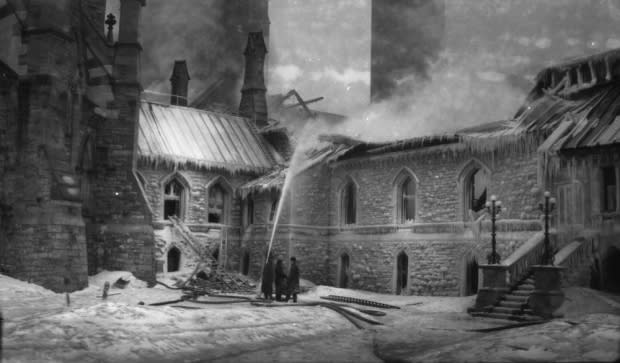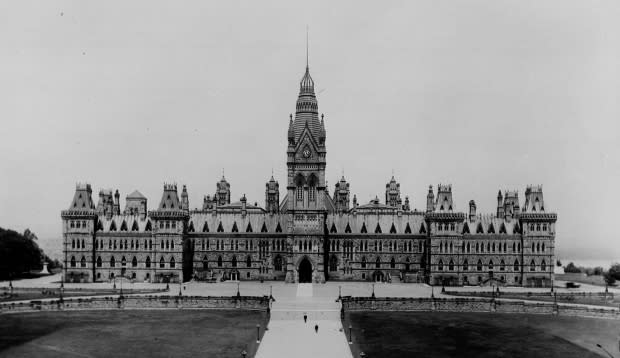Fire watch: Officials have plans to prevent a Notre Dame blaze on Parliament Hill
With images of Notre-Dame Cathedral engulfed in flames still fresh in people's minds, officials in Ottawa are assuring Canadians a plan is in place to protect one of this country's most famous landmarks from a similar tragedy.
A devastating fire swept through the nearly 900-year-old Paris icon on Monday, toppling its historic spire, destroying much of the building's roof and endangering the priceless artwork and artifacts housed inside.
The cause of the fire isn't known for certain; Paris police investigators said Thursday they now believe an electrical short-circuit may have started the blaze.
In Ottawa, the Centre Block on Parliament Hill is in the beginning stages of its own major renovation. The building sits empty. Much of the artwork that once hung on the walls has been moved to the new temporary homes of the House of Commons and the Senate — the West Block and the old Ottawa Conference Centre — across the street from Parliament Hill.
The original benches and desks from the Commons Chamber now sit in the temporary chamber at West Block. Even the Books of Remembrance honouring Canada's war dead have been moved to the Commons' new home.
Centre Block will be a construction site for the next ten years or more. In preparation, officials say they have put in place layers of protections to guard against fire and other hazards.
"We have in place 24 hour fire patrols during any project. We have fire detection systems, alarm systems, and we have all the measures in place to ensure that if there are any issues they're managed extremely quickly," said Rob Wright, the assistant deputy minister responsible for the parliamentary precinct at Public Services and Procurement Canada.
Wright said the overhaul of Centre Block is still in its early stages. Workers are opening walls, floors and ceilings to find out what's behind them.
It's preliminary work for what will be a complete overhaul of the aging structure, set to begin in earnest this fall. As work progresses, Wright said, so too will the safeguards put in place to protect the building from fire.
The safeguards, he said, include "heat detection wires in the building, so that if there's any heat we detect that."
It also includes what Wright said is a 'hot permit' system to provide extra monitoring of "any work that causes any type of heat or flame ...
"So you have to go through a permitting system and you make sure that you have fire watch and make sure that you have eyes on site during any of their work."

He said that when scaffolding goes up around Centre Block, it will be equipped with a standpipe system so that, in the event of fire, firefighters will have easy access to water.
A temporary sprinkler system also could be installed inside parts of Centre Block, Wright said. He said a system like that helped put out a fire that was sparked by a welding torch just over a year ago on the roof of Canada's Four Corners Building, a federal heritage building near Parliament Hill that recently underwent a major renovation.
Wright acknowledges, however, that even the most elaborate emergency procedures can only do so much. There's no guarantee against disaster.
"Accidents can always happen. It's how you respond to accidents that is the most important thing." he said.

On a cold night in February, 1916, fire swept through Canada's Parliament, which stood on the same spot as Centre Block. Seven people were killed. The building, with the exception of the Library of Parliament, was left a smoking ruin.
"It was just an ordinary night," said James Powell of the Historical Society of Ottawa. "The House of Commons was in session, talking about fish prices of all things."
Powell said the fire started in the Reading Room and quickly spread.
"There was an alarm in the in the House, it was set off automatically. Within minutes the fire department was here … but there was really nothing they could do."

Reports from that night describe a scene similar in some respects to the fire at Notre Dame. People in Paris watched in horror as the steeple of their beloved cathedral toppled in flames. In 1916, as the fire raged through Parliament, witnesses spoke of how the bell atop Victoria Tower — the precursor to today's Peace Tower — sounded one last time before the top section of the tower collapsed and the bell came crashing down just after midnight.
There are other similarities as well. Authorities in France are vowing to rebuild Notre Dame. Authorities in Canada set about rebuilding a new Centre Block soon after the 1916 fire.
With that building now undergoing a complete refurbishment, the goal is not only to modernize a historic structure but to make it safer than it ever was, with a modern sprinkler system, fire doors and other security features.
All of which should (hopefully) prevent the kind of catastrophe that has struck Notre Dame, and which struck Parliament Hill more than a century ago.

